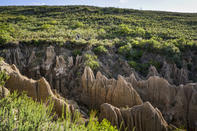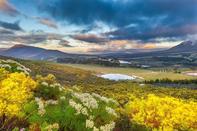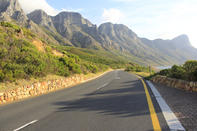Conservation Destinations
The Overberg region encompasses a rich and diverse range of ecosystems. Relic remnants of indigenous montane forest and expansive softwood plantations are juxtaposed with marine estuaries, freshwater marshes, coastal Renosterveld scrub and stands of Cape mountain fynbos against some of the higher-lying slopes.

The selection of conservation destinations in the region boggles the mind. The 37 000 ha De Hoop Nature Reserve preserves freshwater vleis, a diverse intertidal zone and one of the largest remaining expanses of indigenous lowland/coastal fynbos.
Grootvadersbosch Nature Reserve (incorporating the adjacent conservancy and Boosmansbos Wilderness Area) protects the Cape’s most remarkable remaining indigenous forest. Marloth Nature Reserve boasts tea-coloured mountain creeks, plunging waterfalls and swooping singletrack traversing a pristine mountain catchment area.
The Riviersonderend Conservation

The Riviersonderend Conservation area encompasses a 70 000 ha haven where farmland and dense riverine vegetation spill over onto a mix of fynbos – and forested slopes. Salmonsdam Nature Reserve offers a superb mix of relic forest, secret gorges and fynbos ridges, while the Bontebok National Park will leave you cruising a little piece of renosterveld paradise enfolded by the lazy sweep of the Breede River. And last but certainly not least, there is the incomparable Kogelberg Biosphere Reserve, arguably the most diverse and beautiful botanical ‘hot-spot’ anywhere on our lonely blue planet.
Besides the array of magnificent trees, a rich diversity of fauna in the area will delight mountain bikers laying fresh tracks in the great outdoors. Leopard, bushbuck, grey rhebuck, sugarbirds, black harriers and numerous species of reptiles, amphibians and insects inhabit the varied biomes, augmenting the incredible range of attractions awaiting you in the Overberg.
Hemel en Aarde Valley

What makes Hamilton Russell, in the Hemel en Aarde Valley in the Overberg, stand out? Two things. The first is the extensive research conducted by its founder, Tim Hamilton Russell, in growing and producing the Cape's first and best cool-climate noble wines, namely Pinot Noir and Chardonnay. Although Tim also produced Sauvignon Blanc and Pinotage, when his son Anthony bought the place in 1994 he reverted to just the two classic champagne grapes.
The second is that this estate was the first to overstep the polite barrier of R100 a bottle. Both decisions have borne rich fruit. As the current owner Anthony says, “Tiny yields and intense worldwide demand keep the elegant, highly Individual, estate-grown Pinot Noir and Chardonnay in very short supply.”
Clarence Drive

Amazingly, Clarence Drive was upgraded from a track only during WWII, to service naval lookouts around False Bay. Some people say it matches Chapman's Peak Drive on the Cape Peninsula, across the bay and over the mountains, for sheer beauty. It starts (or ends) at Gordon's Bay and follows the eastern rim of that vast expanse of mountain-encircled sea that is False Bay, below the rumpled Steenbras and Kogelberg crags, with the sea pounding far below.
On clear days you'll see dolphins and in season, from July to November, you'll likely spot southern right whales in the translucent surge. There's a nice pub when you reach Rooiels, but you could carry on past Pringle Bay and Betty's Bay to Kleinmond, and return inland via Houw Hoek and the apple-rich farmland before coming down Sir Lowry's Pass. And do not neglect to stop, of course, at one of the outstanding farmstalls en route to stock up on free-range country fare.
 When headed to the Overberg, you’ll find a graveyard of ships and floral riches beyond compare along a coastline patrolled by great white ...
When headed to the Overberg, you’ll find a graveyard of ships and floral riches beyond compare along a coastline patrolled by great white ...